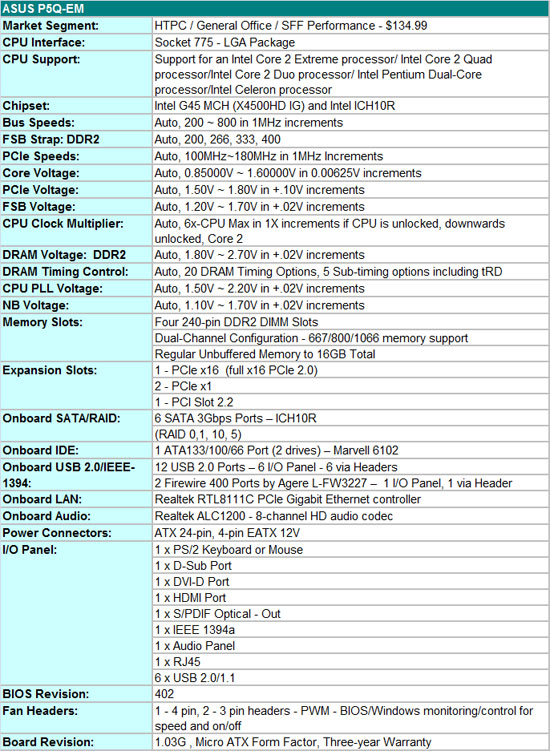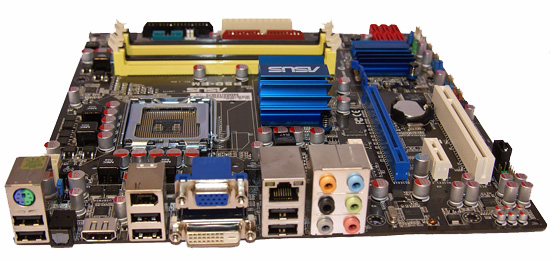The IGP Chronicles Part 1: Intel's G45 & Motherboard Roundup
by Anand Lal Shimpi & Gary Key on September 24, 2008 12:00 PM EST- Posted in
- Motherboards
ASUS P5Q-EM
Our first board up is the ASUS P5Q-EM, which is a worthy successor to the G35 based P5E-VM HDMI. In addition to being the first board that we discuss today, it also happens to be our favorite “all around” board. All four of our boards perform almost identically when it comes to high-definition playback and they all score similarly in our IG based tests. However, if you want a uATX board for your SFF gaming system or plan on overclocking then the ASUS board is a logical choice. Of course, our uATX P45 based DFI P45-T2RS Jr might disagree, but that is a discussion for another time.

In the meantime, the P5Q-EM is a feature rich G45 board featuring an OC friendly BIOS, Gigabit LAN via the almost universal Realtek RTL8111C, IEEE 1394a support, full RAID support along with six SATA ports via the ICH10R, PATA support comes by way of the Marvell 6102, and HD audio via the Realtek ALC1200. Think of the ALC1200 as being the same chipset used by Gigabyte this past year, the ALC889a. However, ASUS does not provide DTS Live and Dolby Home Theater capabilities that Gigabyte does although we understand ASUS is working with DTS on an upgrade. However, one of the main attributes for purchasing a G45 based board is for the multi-channel LPCM output capabilities.
ASUS also provides their Express Gate technology that allows you to access the internet or utilize the most popular IM programs without booting into the OS. Also featured is their EPU-4 engine that provides additional power savings by detecting load conditions and adjusting power in real time. We will have a dedicated look at ASUS' EPU, DES from Gigabyte, and DrMOS from MSI shortly. In the meantime, we were able to save a few watts at various times over the traditional C1E/Speedstep BIOS settings. Fan control and monitoring is good with the capability to set fan speeds based upon thermal conditions in the BIOS or Windows.

In our opinion, ASUS provided an excellent layout considering the space limitations on a Micro ATX board. If the board is utilized in a SFF gaming system, the user is still left with a free PCIe x1 and PCI slot when using a dual slot video card. The heatsink designs did not interfere with a variety of peripherals that we installed including several popular CPU fan/heatsinks and video cards. We have noticed the G45 MCH running a little hot at times but the heatsink design from ASUS was more than capable during testing. We are still waiting for the official death of the floppy drive (and soon the IDE port but we still see value in IDE for a little longer) so the area where these connectors are located can be reclaimed.
ASUS utilizes an excellent four-phase power delivery system along with decent solid capacitors throughout the board that resulted in very stable operation with everything from a Q9650 down to a heavily overclocked E2180. The inclusion of a PS/2 combo port for either a keyboard or mouse is a nice touch for now as we see most suppliers dropping PS/2 support shortly. Other niceties included output support for VGA, HDMI, or DVI-D along with a Firewire port on the IO panel. Overall, the layout is clean, unobtrusive, and will work well for a vast majority of owners.
Pros/Cons
We have to be honest here, up until BIOS 0402, we were not that enamored with this board from an enthusiast's viewpoint. Sure, the basic functionality was there and all peripherals worked fine for a HTPC setup, but the board was not living up to its BIOS options. While this is not important for the vast majority of users looking at IG boards, it is important for users who will use this board as a crossover for a performance oriented SFF system. Our problems ranged from lack of support for the E8600 and Q8200 processors to 8GB compatibility under Vista 64. Additional problems were incurred when overclocking the system as we consistently hit a wall around 415FSB with a 4GB configuration and VCore tended to undervolt severely when set above 1.45V, although with the newer EO steppings you should not have a need for volts that high. Fortunately, most of our performance problems have been solved including overlcocking with memory ratios other than 1:1.
While still not perfect, we were able to attain 455FSB with our Q9300 and 485FSB with the E8600 with aggressive timings, a discreet video card, and 4GB. We are not going to show in-depth overclocking results in today's article since it is oriented towards the chipset introduction with intended use for an office or media application platform. However, if you need an uATX board that offers very good overclocking performance for mainstream users, this board will not disappoint with a discreet video card. We hit a 412FSB wall with the integrated graphics set, not bad at all actually. While video performance is not improved, it is a good way to improve encoding performance with a lower speed processor.
Moving on to more important items for most of us, except for driver, strict EDID adherances, and BD playback problems that are the responsibility of Intel, this board performed admirably throughout IG testing. In our particular setups, we did not have any real problems except for 8GB compatibility under Vista 64 up until BIOS 0402. That said, we think ASUS made a mistake not including an eSATA port on the IO panel. We are also not fans of VGA output or continuing with floppy drive support in this market segment. Both choices would likely be viable options for certain business environments, but we do not see their usefulness in this particular target market. The board worked perfectly when resuming from an S3 state and consistently outperformed the other boards in time to desktop measurements.
While we like the combo PS/2 mouse/keyboard port since it is better than none (yes, we still like the PS/2 keyboard port when overclocking or changing BIOS settings), users with certain wireless keyboard/mouse setups will have to think about upgrading. In fact, PS/2 port availability is something we openly debate, some openly love their inclusion, and some of us just wish we would finally get rid of the legacy ports. We would not have minded a coaxial SPDIF port or IR capability either. Overall, the feature set is impressive for a uATX board and if we only had one wish, it would be adding an eSATA port to the rear IO panel. To reiterate our opinion about this board, if you need a uATX board with versatility then we think this is the board for you.















53 Comments
View All Comments
sprockkets - Wednesday, September 24, 2008 - link
Except the fact that you needed a firmware update on the home theater receiver is just bulls****.Thanks DRM!
I can't wait till VLC gets native blue ray support! At least we have Sly-Soft!
DoucheVader - Friday, September 26, 2008 - link
Hey if it wasn't for a vast majority of people copying stuff, we wouldn't have DRM. I am sick of the complaints. We as consumers created this problem.Most things that have DRM are to protect someone's bread and butter. How would you like it if every time you got paid there was some money missing?
- Saturday, September 27, 2008 - link
Your point might be valid if DRM worked, but can you point out a single mainstream home theater medium on which the DRM means anything to the pirates?DRMed CDs? Ha. Those just pissed off consumers when they inevitable didn't play in some players and/or contained bad software. Often defeated with the frickin shift key.
DVD? People have tattoos of the DeCSS source code it's that damn short. Amusingly the longest lasting DRM scheme, with 2.5 years between the first DVD movie release and the release of DeCSS.
HD-DVD? 253 days, not even a full year after the format first shipped its AACS protection system was cracked. Under three weeks later the first copies start showing up on private trackers.
Blu-Ray (AACS)? The same AACS crack applied to it, and about two weeks after the first HD-DVD copies showed up Blu-Ray was right behind it. Launch to first pirated movie: 225 days.
Blu-Ray (BD+)? Slightly harder than AACS apparently, but titles did not ship with it until October 2007 so the cracking community got off to a late start. AnyDVD HD supported decrypting all BD+ titles roughly 5 months after the first titles shipped and copies again showed up soon after.
I'm less familiar with DVD-Audio and SACD, but my understanding is that there hasn't been a direct "crack" of their respective encryption but instead PC-based players and/or sound drivers are modified to just write the decoded bitstream to the hard drive. This works quite well for audio, as in most cases the compression (if any) applied on the disc is not wanted and the uncompressed PCM stream is exactly what the user desires. For obvious reasons that is not feasible with video.
Once these protections are broken, they do nothing to reduce piracy and only remain to prevent fair-use backups by technologically illiterate users and/or to annoy consumers with crap like these HDCP issues.
It doesn't even matter to the pirate crowd whether the cracks are public or private, as long as someone can do it that means the files will get out, and once they're out they're out.